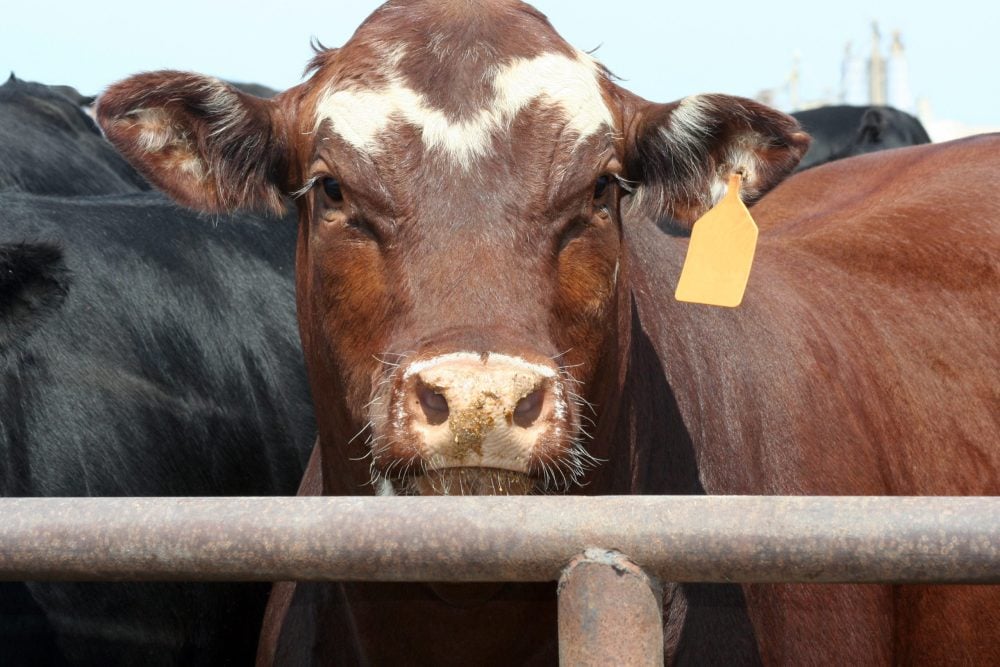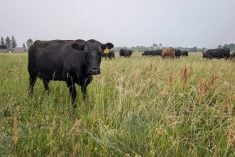Cash-strapped cattle and hog producers in Saskatchewan can expect $71 million in per-head payments through a new provincial support program announced Thursday.
The province’s cattle producers will be eligible for a $40 per head payment for all beef breeding cows and bred beef heifers owned as of Jan. 1, 2009, Agriculture Minister Bob Bjornerud said in a release.
Saskatchewan hog producers, meanwhile, will be eligible for $20 per market hog sold and $10 per head for all isoweanlings, weanlings and feeder hogs produced between July 1, 2008, and Jan. 31, 2009, Bjornerud said.
Feeder cattle and dairy cattle are not eligible for the program, the province said, nor are boars and sows.
Read Also

U.S. livestock: Cattle futures plunge daily limits on beef price fears
Reuters — Most Chicago Mercantile Exchange live cattle and feeder cattle futures contracts fell their respective daily limits on Friday,…
Producers who are eligible for the program can get a minimum payment of $50 and a maximum of $2 million per operation, the province added. The program’s application deadline will be June 15.
The provincial cattle and hog support program (CHSP) “will help producers retain their breeding herds and address immediate cash flow needs,” he said. “In the absence of a national solution, we had to take action to help our producers.”
By that, the ag minister and southeastern Saskatchewan farmer referred to the province’s “repeated requests” for a national livestock assistance program and changes to the federal/provincial AgriStability program.
Bjornerud had previously been vocal about his “disappointment” with the outcome of the federal and provincial agriculture ministers’ meeting Feb. 9 in Ottawa. The federal government was supporting the automotive industry, he said, but the livestock sector, equally important in Western Canada, hasn’t had sufficient federal support.
Cattle and hog producers continue to cope with low prices, high feed costs and limited market access, he said Thursday.
“We will continue to work with our federal counterparts toward a national solution,” he said. “In the meantime, we urge the federal government to come to the table and top up this program with their 60 per cent share, or provide some other form of meaningful support.”
“Soundly rejected”
Federal Agriculture Minister Gerry Ritz retorted Thursday in a separate release that Saskatchewan has had “more than $1 billion” delivered to its producers from Ottawa in the past two years, and noted the provincial government raised this “scheme” at the ag ministers’ meeting.
“Every other province soundly rejected it,” Ritz said. Were such a program to proceed across Canada, he added, it “cannot go forward without support from provincial governments.”
And the other provinces “rejected this scheme for good reason,” said Ritz, who’s also a Saskatchewan farmer. “Federal funding for this type of program would likely result in retaliation from our trading partners. The livestock industry has worked hard to open international markets and that hard work would be completely undone.
“Producers from Saskatchewan and across Canada could lose more money as markets slam shut than they would get from this kind of handout,” he said.
But the Saskatchewan Stock Growers Association, for one, said Thursday that its members “appreciate the efforts (by Bjornerud and the province) to get badly needed financial assistance into the pockets of producers.”
“We are also pleased that the province has made the assistance available through a streamlined process that limits unnecessary bureaucracy,” SSGA president Ed Bothner said in a release.
Bothner also reiterated that the new provincial aid still “falls far short of meeting the needs of many producers” and it’s “critical” that the federal government “step up to the plate and provide the 60 per cent matching contribution which is the well-established precedent in these sorts of situations.”
Bothner cited the market conditions cattle producers have faced since the U.S. and other beef-importing nations closed their ports to Canadian beef and cattle in the wake of Canada’s first homegrown case of BSE in 2003.
“Just as our BSE issues were coming to a resolution, we were confronted by a jump in the value of the Canadian dollar, which impacted export trade, followed by an unprecedented rise in the cost of feed grains.”
Applications for Saskatchewan’s CHSP are available to eligible farmers at RM offices, the Saskatchewan Ministry of Agriculture’s regional offices, on the ministry’s website, by e-mail or through a toll-free call to 1-866-947-9113.
Individual Saskatchewan farmers, farm corporations, co-operatives, partnerships or communal organizations carrying on business and having headquarters in Saskatchewan, and First Nations whose reserve land is in Saskatchewan can take part in CHSP if they own livestock eligible for program payments.















